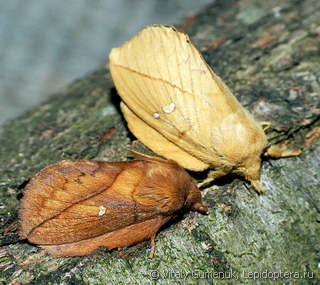Euthrix potatoria
Taxonomy
class Insecta
Species name(s)
Euthrix potatoria (Linnaeus, 1758) = Cosmotriche potatoria = Phalaena potatoria Linnaeus, 1758 = occidentalis Lempke, 1949 = Philudoria potatoria = Euthrix potatoria potatoria = Philudoria potatoria (Linnaeus, 1758) = Philudoria agenjoi De Lattin, 1969 = Philudoria alba Cockayne, 1951 = Odonestis askoldensis Oberthür, 1880 = Philudoria aurantior Lempke, 1960 = Cosmotriche berolinensis Heyne, 1899 = Philudoria bicolor Lempke, 1950 = Cosmotriche brunnea Grabe, 1922 = Cosmotriche brunnea Thierry-Mieg, 1911 = Cosmotriche crucistrigata Lumma, 1938 = Cosmotriche decolor Thierry-Mieg, 1910 = Cosmotriche diminuta Tutt, 1902 = Cosmotriche extrema Tutt, 1902 = Cosmotriche feminalis Grünberg, 1911 = Cosmotriche intermedia Tutt, 1902 = Cosmotriche inversa Caradja, 1895 = Philudoria japonica De Lajonquière, 1978 = Philudoria lilacina Cockayne, 1951 = Cosmotriche lutescens Tutt, 1902 = Cosmotriche midas Bryk, 1941 = Cosmotriche mikado Bryk, 1941 = Cosmotriche nigrescens Lempke, 1937 = Cosmotriche obscura Closs, 1920 = Cosmotriche obsoleta Rebel, 1910 = Cosmotriche obsoleta-berolinensis Tutt, 1902 = Cosmotriche obsoleta-extrema Tutt, 1902 = Cosmotriche obsoleta-lutescens Tutt, 1902 = Cosmotriche obsoleta-potatoria Tutt, 1902 = Philudoria occidentalis Lempke, 1950 = Cosmotriche pallida Spuler, 1908 = Cosmotriche proxima Tutt, 1902 = Philudoria rosea Lempke, 1950 = Philudoria sordidula Cockayne, 1951 = Cosmotriche suffusa Closs, 1917 = Philudoria transitoria Lempke, 1950 = Philudoria uniformis Cockayne, 1951 = Cosmotriche unimacula Foltin, 1942 = Philudoria variegata Cockayne, 1951. [9, 10, 85, 122, 187]
Drinker Moth.
urn:lsid:insecta.pro:taxonomy:6301
Expansion
This species marks on the maps: 13.
Zoogeographical regions
Palaearctic.
Russia regions
#1. Kaliningradsky; #2. Kolsky; #3. Karelsky; #4. Evropeisky Severo-Zapadny; #7. Evropeisky yuzhno-tayozhny; #8. Evropeisky Tsentralny; #9. Evropeisky Tsentralno-Chernozyomny; #10. Sredne-Volzhsky; #11. Volgo-Donsky; #13. Zapadno-Kavkazsky*; #16. Sredne-Uralsky; #17. Yuzhno-Uralsky; #19. Sredneobsky; #20. Yuzhno-Zapadnosibirsky; #22. Krasnoyarsky; #24. Gorno-Altaisky; #25. Tuvinsky; #26. Predbaikalsky; #27. Pribaikalsky; #28. Zabaikalsky; #29. Zapadno-Yakutsky; #36. Sredne-Amursky; #37. Nizhne-Amursky; #38. Sakhalin; #39. Yuzhno-Kurilsky; #40. Primorsky.
* An asterisk denotes a region for which the species is listed as an migrant or information that requires additional checking.
Forewing length
28—39 mm.
Wingspan
46—70 mm.
Primary colors
Yellow, Brown/Gray/Black.
Flight time
| January | February | March | April | May | June | July | August | September | October | November | December |
Larva lifespan
| January | February | March | April | May | June | July | August | September | October | November | December |
Detailed information with references
Taxonomy, synonyms and combinations
Distribution
Imago Habitus and Differences from alike species
General info about Imago
Imago lifespan
General info about Larva
Larva food plants / other food objects
Larva lifespan
Pupa
Egg
Overwintering stage
Subspecies of Euthrix potatoria
- Euthrix potatoria bergmanni Bryk, 1941. [187]
- E. p. potatoria (Linnaeus, 1758). [10]
Authors
Initial species uploading to the site: Peter Khramov.
Text data: Peter Khramov, Vasiliy Feoktistov.
The species characteristics formalization: Peter Khramov, Vasiliy Feoktistov.
References
- [1] O. Karsholt, J. Razowski (eds.), 1996. The Lepidoptera of Europe: a distributional checklist
- [3] Каталог чешуекрылых (Lepidoptera) России. Под ред. С. Ю. Синёва. СПб.; М.: Товарищество научных изданий КМК, 2008
- [9] Tree of Life (funet.fi), 2012
- [10] de Jong, Y.S.D.M. (ed.) (2011) Fauna Europaea version 2.4 (faunaeur.org)
- [28] Moths and Butterflies of Europe and North Africa (leps.it), 2012
- [85] Lepidoptera species catalogue, Lepidoptera.ru, 2015
- [187] Species 2000, http://www.sp2000.org
- [PC93] Vasiliy Feoktistov
Comments
Note: you should have a Insecta.pro account to upload new topics and comments. Please, create an account or log in to add comments
Euthrix potatoria photos







































































































All the photos of the species in large size
Please, create an account or log in to upload your photo




